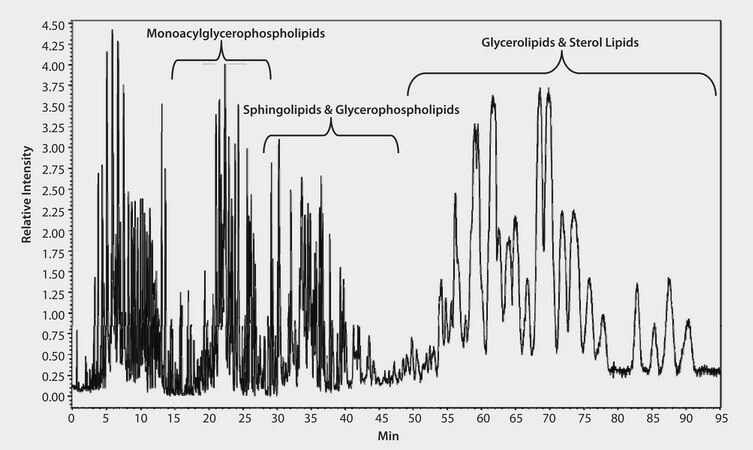LC/ESI/MS-TOF (Positive TIC) of Triacylglycerols in Human Plasma on Ascentis® Express C18

Materials
related product
CONDITIONS
column
Ascentis Express C18, 15 cm × 2.1 mm I.D., 2.7 μm particles (53825-U)
mobile phase
20 mM ammonium formate, 0.1% formic acid in water [A] or methanol [B]
gradient
2 to 40% B in 2 min; to 92.5% B in 23 min; to 95% B in 7 min; to 100% B in 1 min; held at 100% B (note: flow rate increased to 0.5 mL/min at 42 min)
flow rate
0.4 mL/min (flow rate increased to 0.5 mL/min at 42.01 min)
flow rate
50 °C
detector
MS (TOF), 70–1200 m/z
injection
the effluent from the HPLC column was directly flowed into the IT-TOF- MS instrument
sample
human plasma extracted according to the Folch method and transesterified, approx. 10 mg/mL
Description
Analysis Note
detector: The MS acquisition was performed using an ESI interface simultaneously operated in both positive and negative ionization mode, under the following conditions: CDL temperature, 200 °C; block heater temperature, 200 °C; nebulizing gas flow (nitrogen), 1.5 L/min, detector voltage 1.5 Kv. MS data were acquired in the 200–1200 m/z range, using 30 ms ion accumulation time (repeat = 3). Tandem MS data were acquired in the 70–1200 m/z range, using 30 ms ion accumulation time (repeat = 3, tolerance 0.05 m/z) and automatic precursor ion selection (width: 3 Da, CID parameters: energy 50%, collision gas (argon) 50%, execution trigger (BPC) intensity at 95% stop level).
Data provided by Professor Luigi Mondello, Analytical Chemistry/Food Chemistry Laboratories, University of Messina, Italy.
This figure shows a representative plasma lipid total ion chromatogram (TIC) that highlights the regions in which each major lipid class elutes. Under RP-LC conditions lipid classes elute in order of increasing hydrophobicity. Separation was achieved on an Ascentis Express C18 column packed with Fused-Core particles.
Legal Information
Ascentis is a registered trademark of Merck KGaA, Darmstadt, Germany